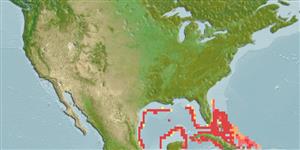Elasmobranchii (haaien en roggen) (sharks and rays) >
Carcharhiniformes (Ground sharks) >
Scyliorhinidae (Cat sharks) > Scyliorhininae
Etymology: Scyliorhinus: skylion, Greek for dogfish or small shark; rhinus, from rhine (Gr.), rasp, alluding to a shark’s jagged, rasp-like skin. (See ETYFish); torrei: In honor of Cuban zoologist Carlos de la Torre (1858-1950), who recognized this species as new and granted Howell Rivero permission to study and describe it. (See ETYFish).
Environment: milieu / climate zone / depth range / distribution range
Ecologie
marien bathydemersaal; diepte 200 - 600 m (Ref. 55584), usually 366 - 550 m (Ref. 244). Deep-water; 30°N - 20°N
Western Central Atlantic: southern Florida (USA), Bahamas, and Cuba.
Grootte / Gewicht / Leeftijd
Maturity: Lm ? range ? - ? cm
Max length : 32.0 cm TL mannelijk / geslacht onbekend; (Ref. 244)
Korte beschrijving
Morfologie | Morfometrie
Broad rounded snout. Pale brown back and upper sides transversely marked by series of indistinct darker blotches. Finer markings consist of small oval whitish spots, evenly distributed over the whole back and upper sides (Ref. 6032).
Found on the upper continental slope. Little is known of its biology. Oviparous (Ref. 50449).
Levenscyclus en paargedrag
Maturiteit | Voortplanting | Paaien | Eieren | Fecunditeit | Larven
Oviparous, paired eggs are laid. Embryos feed solely on yolk (Ref. 50449).
Compagno, L.J.V., 1984. FAO Species Catalogue. Vol. 4. Sharks of the world. An annotated and illustrated catalogue of shark species known to date. Part 2 - Carcharhiniformes. FAO Fish. Synop. 125(4/2):251-655. Rome: FAO. (Ref. 244)
Status op de Rode Lijst van het IUCN (Ref. 130435)
Gevaar voor de mens
Harmless
Gebruik door de mens
Visserij: van geen belang
Meer informatie
Leeftijd/GrootteGroeiLengte-gewichtLengte-lengteLengtefrequentiesMorfometrieMorfologieLarvenLarvale populatiedynamiekRekruteringAbundantieBRUVS
ReferentiesAquacultuurAquacultuurprofielKweeklijnenGeneticaElectrophoresesErfelijkheidZiektesVerwerkingNutrientsMassaconversie
Tools
Warning: mysqli::__construct(): (08004/1040): Too many connections in /var/www/html/includes/speciessummary.lib.php on line 2414
Can't connect to MySQL database fbquizv2. Errorcode: Too many connections
